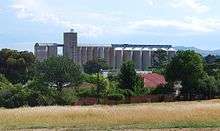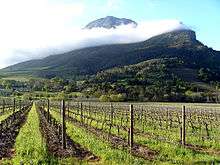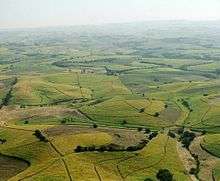Agriculture in South Africa

Agriculture in South Africa contributes around 10% of formal employment, relatively low compared to other parts of Africa, as well as providing work for casual labourers and contributing around 2.6 percent of GDP for the nation.[1] Due to the aridity of the land, only 13.5 percent can be used for crop production, and only 3 percent is considered high potential land.[2]
According to FAOSTAT, South Africa is one of the world's largest producers of: chicory roots (4th); grapefruit (4th); cereals (5th); green maize and maize (7th); castor oil seed (9th); pears (9th); sisal (10th); fibre crops (10th).[3] The dairy industry consists of around 4,300 milk producers providing employment for 60,000 farm workers and contributing to the livelihoods of around 40,000 others.[4]
The South African government has set a target of transferring 30% of productive farmland from whites to 'previously disadvantaged' blacks by 2014.[5] Land reform has been criticised both by farmers' groups and by landless workers, the latter alleging that the pace of change has not been fast enough, and the former alleging 'racist' treatment and expressing concerns that a similar situation to Zimbabwe's land reform policy may develop,[6] a fear exacerbated by comments made by former deputy president Phumzile Mlambo-Ngcuka.[7][8]
The government has been accused of either putting in too much effort,[9] or not enough effort,[10] to tackle the problem of farm attacks as opposed to other forms of violent crime.
Some predictions show surface water supply could decrease by 60% by the year 2070 in parts of the Western Cape.[11] To reverse the damage caused by land mismanagement, the government has supported a scheme which promotes sustainable development and the use of natural resources.[12] Maize production, which contributes to a 36% majority of the gross value of South Africa's field crops, has also experienced negative effects due to climate change. The estimated value of loss, which takes into consideration scenarios with and without the carbon dioxide fertilisation effect,[13] ranges between tens and hundreds of millions of Rands.[14]
History

There is evidence that slash and burn agriculture was first brought to South Africa by the Bantu expansion, by about the 4th century AD.
The earliest written record of farming life in South Africa start slightly after 1500.
Crops
Cereals and grains

Grains and cereals are South Africa's most important crops, occupying more than 60 percent of hectare under cultivation in the 1990s. Maize, the country's most important crop, is a dietary staple, a source of livestock feed, and an export crop. Government programs, including generous loans and extension services, have been crucial to the country's self-sufficiency in this enterprise. Maize is grown commercially on large farms, and on more than 12,000 small farms, primarily in North-West, Mpumalanga (formerly, Eastern Transvaal), Free State (formerly, the Orange Free State), and KwaZulu-Natal provinces. Maize production generates at least 150,000 jobs in years with good rainfall and uses almost one-half of the inputs of the modern agricultural sector.
Maize production exceeds 10 million tons in good years; owing to regional drought in the early 1990s, however, production fell to just over 3 million tons in 1992, and roughly 5 million tons of maize were imported, at a cost of at least US$700 million. Both domestic and imported maize was shipped to neighbouring countries to help ease the regional impacts of the drought. The drought eased in 1993, and officials estimated the 1994 harvest at approximately 12 million tons. Below-average rainfall in late 1994 again threatened to reduce maize output in 1995, and officials expected to import some 600,000 tons of maize in that year. Plentiful rain in late 1995 provided for a bumper crop in 1996.
Wheat production, which is concentrated in large, highly mechanised farms, also increased after World War II. Wheat cultivation spread from the western Cape where rainfall is fairly reliable, to the Orange Free State and the eastern Transvaal, primarily in response to rising consumer demand. But wheat harvest volumes vary widely; for example, roughly 2.1 million tons were produced in 1991 and only 1.3 million tons in 1992. Production in the early 1990s failed to meet local demand for about 2.2 million tons per year. Wheat imports in 1992, for example, cost more than US$5 million.
Other small grains are grown in localised areas of South Africa. For example, sorghum—which is native to southern Africa—is grown in parts of the Free State, as well as in the North-West and the Northern provinces, with yields often exceeding 200,000 tons. Sorghum has been used since prehistoric times for food and brewing purposes. Barley is also grown, primarily in the Western Cape. Nearly 300,000 tons of barley were produced in 1995.
South Africa produces peanuts, sunflower seeds, beans, and soybeans. Annual production of these crops varies significantly from year to year, although South Africa is usually able to meet domestic vegetable-oil needs and generate some exports. Plentiful rains in late 1995 meant increased harvests of these crops in 1996, compared to 1994 and 1995.
Fruit and wine farming

Fruits, including grapes for wine, earn as much as 40 percent of agricultural export earnings in some years. (Fresh fruit finds a good market in Europe because it matures during the northern hemisphere's winter.) Deciduous fruits, including apples, pears, and peaches, are grown primarily in areas of the Western Cape and the Eastern Cape, where cold winters and dry summers provide ideal conditions for these crops. Almost 1 million tons of deciduous fruits were sold fresh locally or were exported each year in the early 1990s.
Pineapples are grown, primarily in the Eastern Cape and KwaZulu-Natal. Tropical fruits—especially bananas, avocados, and mangoes—are also grown, especially in the northeast and some coastal areas. More than half of citrus production is exported in most years. South Africa exported 40 million cartons of citrus fruit in 1994, earning roughly R1.34 billion, according to industry sources.
More than 1.5 million tons of grapes are used domestically in South Africa's renowned wine industry, which dates back to the seventeenth-century vineyards introduced by French Huguenot immigrants. More than 100,000 hectares of land are planted in vineyards, centred primarily in the Western Cape. Smaller vineyards are also found in the Northern Cape, Free State, and Northern Province. One of the noticeable signs of the end of international sanctions against South Africa was a dramatic increase in worldwide demand for South African wines in 1994 and 1995.
Sugarcane

Sugarcane is also an important export crop, and South Africa is the world's tenth largest sugar producer. Sugarcane was first cultivated in mid-nineteenth-century Natal. Production is still centred there, but sugar is also grown in Mpumalanga, where irrigation is used when rainfall is inadequate. Land under sugar cultivation has steadily increased, and the industry estimated that it produced more than 16 million tons of sugarcane in 1994.
Statistics
Value in millions of South African rand:[15]
| Commodity | 2009 |
|---|---|
| Poultry | 23,165 |
| Maize | 16,346 |
| Cattle and calves | 12,808 |
| Wheat | 6,356 |
| Milk | 9,138 |
| Deciduous and other fruit | 8,040 |
| Vegetables | 7,843 |
| Sugar cane | 4,769 |
| Citrus | 4,628 |
| Potatoes | 4,058 |
Production of important field crops:
| Commodity | 2009[16]
(tons) |
2015[17] (fifth forecast)
(tons) |
|---|---|---|
| Canola | 40 350 | 101 500 |
| Sugar cane | 20 411 000 | |
| Malting barley | 216 000 | 357 487 |
| Maize | 12 567 000 | |
| Vegetables | 2 442 000 | |
| Citrus | 2 218 000 | |
| Wheat | 1 928 000 | 1 501 190 |
| Deciduous and other fruit | 1 829 000 | |
| Sunflower seed | 833 000 | |
| Subtropical Fruit | 655 000 | |
Agricultural cooperatives
There are a number of Agricultural cooperatives in South Africa, including:
Droughts
In 2015 South Africa experienced the worst drought in 30 years.[18] Many farmers lost whole crops and much of their livestock. South Africa's dams also showed a decline with the Pongolapoort dam losing 20% of its water in just one year.[19]
See also
- Department of Agriculture (South Africa)
- South African farm attacks
- Western Cape 2012 Farm Workers' Strike
References
- ↑ Human Rights Watch, 2001. Unequal Protection: The State Response to Violent Crime on South African Farms, ISBN 1-56432-263-7.
- ↑ Mohamed, Najma. 2000. "Greening Land and Agrarian Reform: A Case for Sustainable Agriculture", in At the Crossroads: Land and Agrarian Reform in South Africa into the 21st century, ed. Cousins, Ben. Bellville, School of Government, University of the Western Cape. ISBN 1-86808-467-1.
- ↑ "FAOSTAT 2008 by Production". faostat.fao.org. Archived from the original on 13 July 2011. Retrieved 6 June 2008.
- ↑ "Agriculture". South Africa Online. Retrieved 17 July 2006.
- ↑ Berger, Sebastien (21 October 2009). "Congo hands land to South African farmers". The Daily Telegraph. UK. Retrieved 30 October 2011.
- ↑ "South Africa's bitter harvest". The Times. UK. Retrieved 30 October 2011.
- ↑ "South Africans' long wait for land". BBC News. 27 July 2005. Retrieved 30 October 2011.
- ↑ "SA 'to learn from' land seizures". BBC News. 11 August 2005. Retrieved 30 October 2011.
- ↑ Bronwen Manby (August 2001). Unequal Protection – The State Response to Violent Crime on South African Farms. Human Rights Watch. ISBN 1-56432-263-7. Retrieved 28 October 2006.
- ↑ "Farms of Fear". The Times. UK. 7 April 2011. Retrieved 30 October 2011.
- ↑ Climate change to create African 'water refugees' – scientists, Reuters Alertnet. Accessed 21 September 2006]. Archived 25 October 2010 at the Wayback Machine.
- ↑ "Department of Agriculture South Africa". Nda.agric.za. Retrieved 30 October 2011.
- ↑ "The CO2 fertilization effect: higher carbohydrate production and retention as biomass and seed yield". Fao.org. Retrieved 30 October 2011.
- ↑ J. Turpie; et al. (2002). "Economic Impacts of Climate Change in South Africa: A Preliminary Analysis of Unmitigated Damage Costs" (PDF). Joint Center for Political and Economic Studies Inc. Southern Waters Ecological Research & Consulting & Energy & Development Research Centre. Archived from the original (PDF) on 25 March 2009.
- ↑ South Africa Yearbook 2010/11. p. 39.
- ↑ South Africa Yearbook 2010/11. p. 42.
- ↑ Dredge, Rodney D. (15 December 2015). "Crop Estimates Committee" (PDF). Agriculture, Forestry & Fisheries. South African Department of Agriculture, Forestry & Fisheries Statistics and Economic Publications and Reports. Retrieved 26 January 2016.
- ↑ "South Africa grapples with worst drought in 30 years - BBC News". Retrieved 2016-09-01.
- ↑ Fernandes, Luis. "Dam levels drop as drought is set to worsen". www.enca.com. Retrieved 2016-09-01.
External links
| Wikimedia Commons has media related to Agriculture in South Africa. |
![]() This article incorporates public domain material from the Library of Congress Country Studies website http://lcweb2.loc.gov/frd/cs/.
This article incorporates public domain material from the Library of Congress Country Studies website http://lcweb2.loc.gov/frd/cs/.